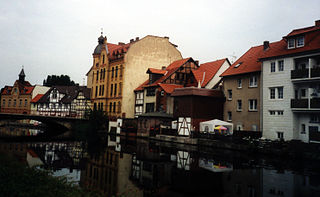
Eschwege, the district seat of the Werra-Meißner-Kreis, is a town in northeastern Hesse, Germany. In 1971, the town hosted the eleventh Hessentag state festival.
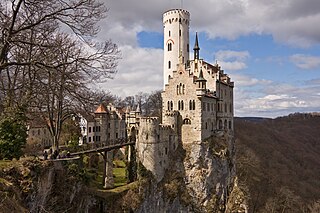
Lichtenstein Castle is a privately-owned Gothic Revival castle located in the Swabian Jura of southern Germany. It was designed by Carl Alexander Heideloff and its name means "shining stone" or "bright stone". The castle overlooks the Echaz valley near Honau, Reutlingen in the state of Baden-Württemberg. The modern castle was inspired by the novel Lichtenstein (1826) by Wilhelm Hauff and was built in 1840–1842. The ruins of an older medieval castle are a few hundred meters away.
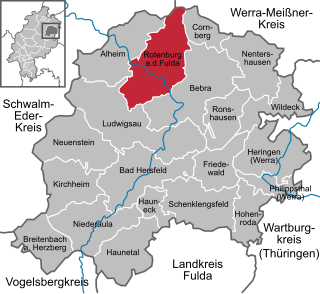
Rotenburg an der Fulda is a town in Hersfeld-Rotenburg district in northeastern Hesse, Germany lying, as the name says, on the river Fulda.

Spangenberg is a small town in northeastern Hesse, Germany.
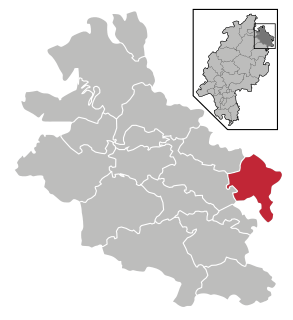
Wanfried is a town in the Werra-Meißner-Kreis in northeasternmost Hesse, Germany. It is classified as a Landstadt, a designation given in Germany to a municipality that is officially a town (Stadt), but whose population is below 5,000. It literally means “country town”.

Barchfeld is a village and a former municipality in the Wartburgkreis district of Thuringia, Germany. Since 31 December 2012, it is part of the municipality Barchfeld-Immelborn.
The Dernbach Feud was an over 100-year-long ongoing dispute in present-day Germany between the House of Nassau, several knightly families, and the Landgrave of Hesse. The conflict erupted mainly over property rights in Herborn and the surrounding area.

Gifhorn Castle is a castle in Gifhorn, Germany, built between 1525 and 1581 in the Weser Renaissance style. The castle was fortified until 1790 with moats, ramparts and bastions and was never captured. In the 16th century it was the Residenz of the Duchy of Gifhorn under Duke Francis of Brunswick-Lüneburg for just 10 years.

Heiligenburg Castle is a castle on the hill of Heiligenberg in the district of Schwalm-Eder-Kreis, Hesse, Germany.

Amalie Elisabeth of Hanau-Münzenberg (1602–1651) was Landgravine consort and Regent of Hesse-Kassel. She married the future William V, Landgrave of Hesse-Kassel in 1619 and became Landgravine upon his ascension to power in 1627. In 1637, military defeats forced her and William V into exile in East Frisia. Later that year, she became regent for their son William VI upon her husband's death. Through skillful diplomacy and military successes in the Thirty Years' War, she advanced the fortunes of Hesse-Kassel and influenced the Peace of Westphalia that brought the conflict to an end. She handed over an enlarged landgraviate to her son when she abdicated upon his majority in 1650. However, her health had deteriorated over the course of the war, and she died soon after her abdication in 1651.
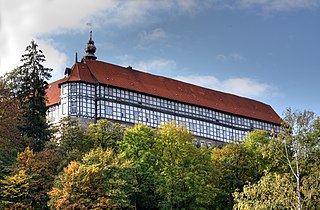
Herzberg Castle is a German schloss in Herzberg am Harz in the district of Göttingen in the state of Lower Saxony. The present-day, quadrangular building has its origins in the 11th century as a medieval castle. After a fire in 1510 it was rebuilt as a schloss and is one of the few in Lower Saxony that was constructed as a timber-framed building. Because it belonged to the House of Welf for 700 years it is also known as the Welf Castle of Herzberg.
Anna, Princess of Mecklenburg-Schwerin was by marriage Landgravine of Hesse.
Anna of Saxony was a princess of Saxony and by marriage landgravine of Hesse.

Herborn Castle is situated right above the city of Herborn, in the Lahn-Dill district of the state of Hesse, Germany.
Schaudichnichtum Lodge ( was a former hunting lodge southwest of the town of Bad Dürkheim in the German state of Rhineland-Palatinate. Like its near neighbours, Kehrdichannichts, Murrmirnichtviel and Jägerthal, it was used as accommodation for the nobility of the Electoral Palatinate during the 18th century when they went hunting in the Palatine Forest.

Otzberg Castle in the German state of Hesse is a medieval castle on the summit of the Otzberg in the Odenwald forest at a height of 367 m above NN. On its northern slopes is the village of Hering, which grew out of the lower ward or castellan's settlement. The history of castle and village is therefore closely interwoven.

The Sababurg, first called the Zappenburg, then Zapfenburg and today, after the Brothers Grimm fairy tale Sleeping Beauty Castle, is the ruin of a hill castle in the legendary Reinhardswald, a forested upland that runs through the North Hessian county of Kassel. Sababurg is also the name of a district of the town of Hofgeismar in which the castle is found.

Schloss Holzheim is a former hunting seat of the ruling family of Hesse-Kassel, located in the village of Holzheim in the German state of Hesse, approximately 80 kilometres (50 mi) south of Kassel. The hunting lodge was built between 1732 and 1735 under Frederick I, King of Sweden and also Landgrave of Hesse-Kassel, in baroque style on the medieval foundation walls of the former manor house of the local noble families Von Holzheim and Von Romrod. Frederick's father, Landgrave Charles I, Landgrave of Hesse-Kassel had often come here for hunting. Frederick's brother and governor, Prince William, liked to be here as well because of the rich game population of the forest areas around the princely estate.

Schloss Pyrmont, sometimes called Pyrmont Castle, was a schloss and the summer residence of the counts of Spiegelberg and counts of Waldeck-Pyrmont in the present-day German town of Bad Pyrmont. The current building dates to the 18th century and houses a museum. The schloss is part of Pyrmont Fortress which dates to the 16th century.
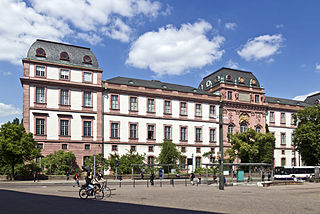
The Residential Palace Darmstadt is the former residence and administrative seat of the landgraves and from 1806 to 1919 of the Grand Dukes of Hesse-Darmstadt. It is located in the centre of the Hessian city of Darmstadt.






















